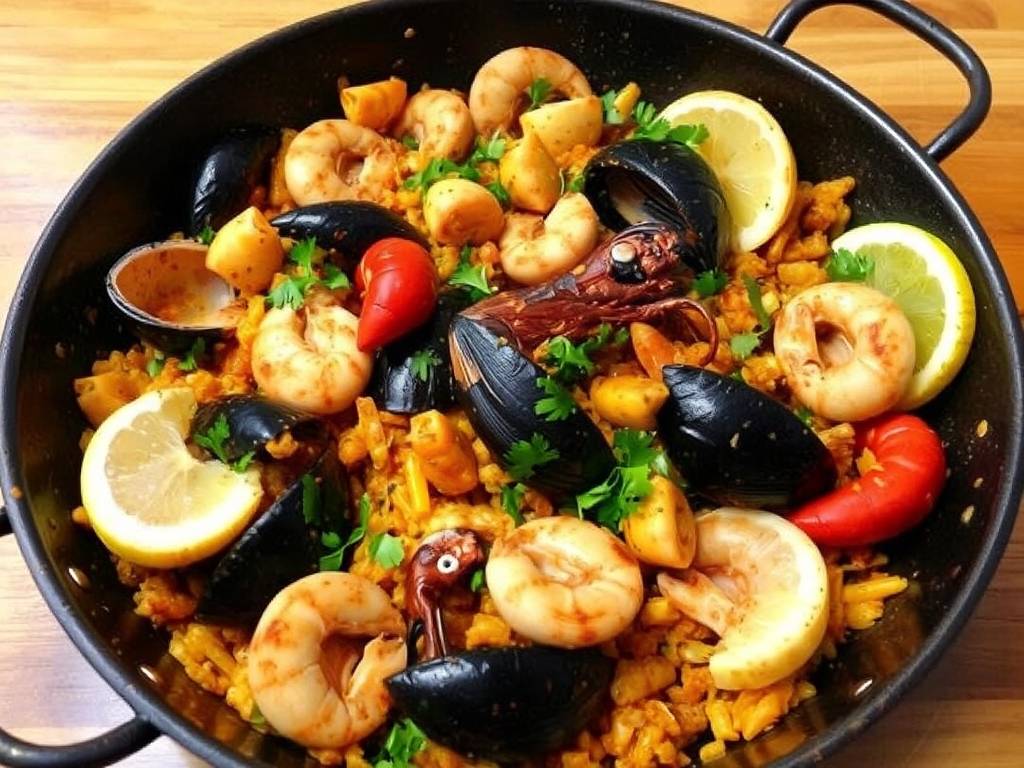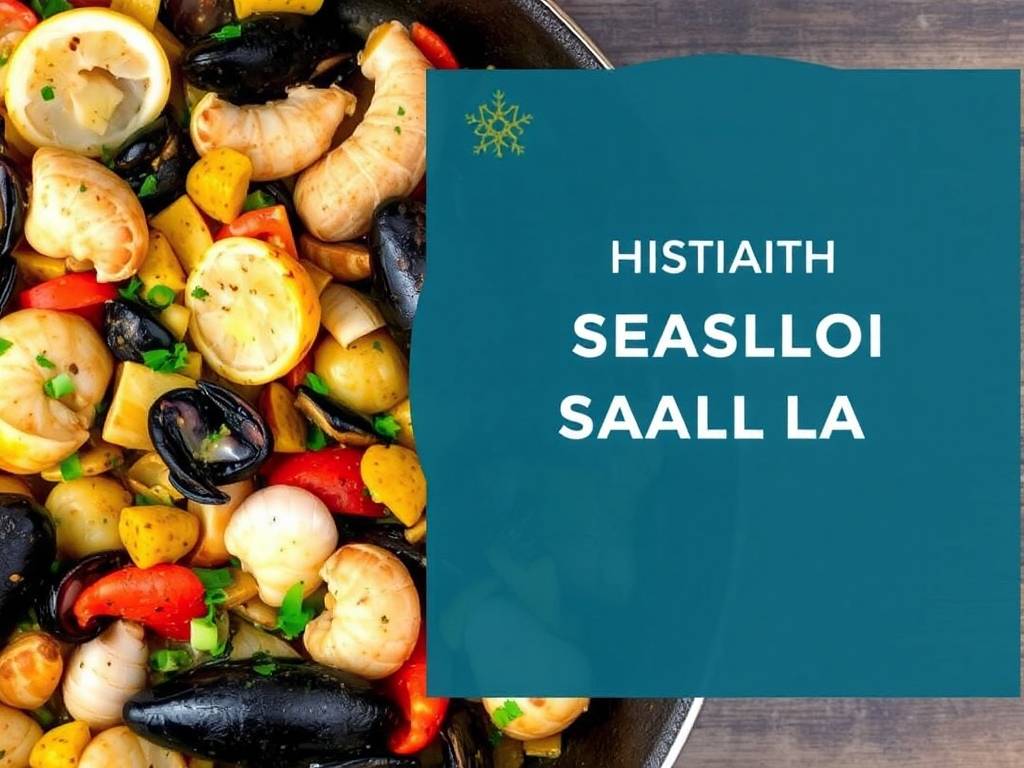The Ultimate Guide to Crafting Authentic Seafood Paella with Shellfish at Home
There's something truly magical about a steaming pan of seafood paella with shellfish. The vibrant saffron-infused rice, the briny aroma of the ocean, and the communal joy of sharing it straight from the pan—it’s more than a meal; it’s an experience. Many home cooks are intimidated by the thought of making this Spanish classic, fearing it's too complex or requires elusive ingredients. I'm here to tell you that with the right guidance, you can create a stunning, restaurant-quality shellfish paella recipe right in your own kitchen. This guide will walk you through every single step, demystifying the process and empowering you to become the paella master of your next gathering.
Let's start by gathering our ingredients. The soul of a great paella lies in its components. For a paella that serves four to six people, you will need:

For the Broth & Flavor Base:
- 4 cups of high-quality fish or seafood stock
- 1 large pinch of genuine saffron threads (about ½ teaspoon)
- ½ cup dry white wine
- 1 large onion, finely diced
- 1 large red bell pepper, finely diced
- 4 cloves garlic, minced
- 1 (14.5 oz) can of diced tomatoes, drained
- ½ cup extra-virgin olive oil
- 1 teaspoon sweet smoked paprika (pimentón de la Vera)
- Salt to taste
For the Rice:
- 2 cups Spanish short-grain rice (such as Bomba or Calasparra). This type of rice is crucial as it absorbs a tremendous amount of liquid without becoming mushy.
For the Shellfish Selection:
- 12-16 large raw shrimp, shells on (for maximum flavor)
- 1 lb fresh mussels, scrubbed and debearded
- 1 lb fresh clams (like littlenecks or Manila clams), scrubbed
- 8-12 large sea scallops
- Optional: ½ lb squid, cleaned and sliced into rings
The Essential Paella Pan and Equipment
Before we dive into the cooking method, let's talk about the iconic paella pan, or paellera. This wide, shallow, two-handled pan is not just for show; it's a functional masterpiece. Its large surface area allows for a thin layer of rice, which is the secret to achieving the coveted socarrat—the delicious, slightly crispy crust that forms at the bottom of the pan. If you don't have a traditional paella pan, the widest, heaviest-bottomed skillet you own will work as a substitute. You'll also need a sturdy heat source. While cooking over an open fire is traditional, a large gas burner on your stovetop provides excellent, even heat control.
Step-by-Step Cooking Method for Perfect Shellfish Paella

Step 1: Infuse Your Broth This is our first secret step to a deeply flavorful paella. In a saucepan, gently heat your fish stock. Crush the saffron threads between your fingers and add them to the warm stock, allowing them to steep. This "blooming" process releases the saffron's beautiful golden color and distinct aroma into the liquid, ensuring it permeates every grain of rice.
Step 2: Build the Sofrito The sofrito is the flavor foundation of your paella. Place your paella pan over medium-high heat and add the olive oil. Sauté the diced onion and bell pepper until they are soft and tender, about 8-10 minutes. Add the minced garlic and cook for another minute until fragrant. Stir in the drained diced tomatoes and the smoked paprika. Cook this mixture, stirring occasionally, until it has thickened and darkened slightly, and the oil begins to separate. This slow cooking caramelizes the vegetables, creating a rich, sweet, and savory base. This is where the foundational flavor of your authentic Spanish seafood paella is built.
Step 3: Toast the Rice and Deglaze Add the 2 cups of Spanish rice to the sofrito. Stir constantly for about 1-2 minutes, toasting the rice until the edges become slightly translucent. This step helps the rice absorb liquid more effectively later on. Now, pour in the white wine. It will sizzle and steam—this is a good thing! Scrape up any browned bits from the bottom of the pan as the wine reduces by half.
Step 4: The Simmer and the First Layer of Shellfish Now, pour in your warm, saffron-infused broth. Season generously with salt. Give everything one good stir to distribute the rice evenly, then—and this is important—do not stir again. Stirring will release the starch from the rice and make your paella gummy, like a risotto. We want separate, distinct grains.
Arrange your first layer of shellfish. Nestle the raw shrimp and scallops into the rice. The rice will cook around them, allowing their juices to seep into the dish.
Step 5: Add the Steaming Shellfish and Achieve Socarrat After about 10 minutes of cooking, the rice will have absorbed a significant amount of liquid. Now, artfully arrange the mussels and clams on top, pushing them hinge-side down into the rice. The steam from the cooking rice will open them perfectly.
Continue to cook over medium heat for another 8-12 minutes. As the liquid reduces, you will hear a faint crackling sound. This is the sound of socarrat forming! To check, carefully tilt the pan and look for a golden-brown crust at the edges. If you want a more pronounced socarrat, you can increase the heat for the final minute, but watch it closely to avoid burning.
Step 6: The Rest is Crucial Once the rice is cooked, the liquid is absorbed, and the shellfish have opened (discard any that remain closed), remove the pan from the heat. Cover the entire pan with a clean kitchen towel or a large piece of foil and let it rest for 5-10 minutes. This resting period is non-negotiable. It allows the rice to "settle," absorb any remaining steam, and become perfectly fluffy. It also makes it easier to achieve that beautiful socarrat when you serve.
Serving and Enjoying Your Masterpiece Bring the entire pan to the table—this is the true Spanish way. Garnish with fresh lemon wedges and a sprinkling of chopped fresh parsley. The combination of tender, flavorful rice, juicy shrimp, sweet scallops, and briny clams and mussels is a symphony of textures and tastes. Squeeze fresh lemon juice over the top to brighten all the flavors. This easy paella with shrimp and mussels is meant to be shared, so provide everyone with a spoon and dig in directly from the pan for the ultimate communal dining experience.
Troubleshooting Common Paella Problems
- My rice is undercooked/too hard. This means the liquid was absorbed too quickly. Next time, add a bit more hot broth or water during cooking. You can also cover the pan with foil for the last few minutes to steam the top.
- My rice is mushy. You may have used the wrong type of rice (like a long-grain) or stirred it during cooking. Remember, no stirring after the broth goes in!
- I didn't get any socarrat. The heat was likely too low at the end. Ensure you have a good, consistent medium heat for the final 5-7 minutes of cooking. Listen for the crackle!
- My shellfish is overcooked. If using delicate shellfish like shrimp and scallops, adding them in the final 8-10 minutes of cooking, rather than at the beginning, can prevent this.
With this comprehensive guide, you have all the tools and knowledge to create a breathtakingly delicious seafood paella with shellfish. It’s a rewarding culinary project that celebrates fresh ingredients and joyful sharing. So, gather your friends, pour a glass of crisp Albariño wine, and get ready to impress with your newfound skills in crafting the perfect homemade shellfish paella.






发表评论